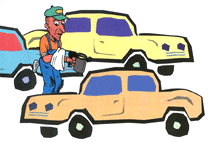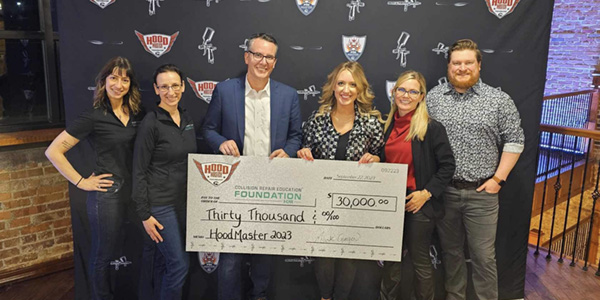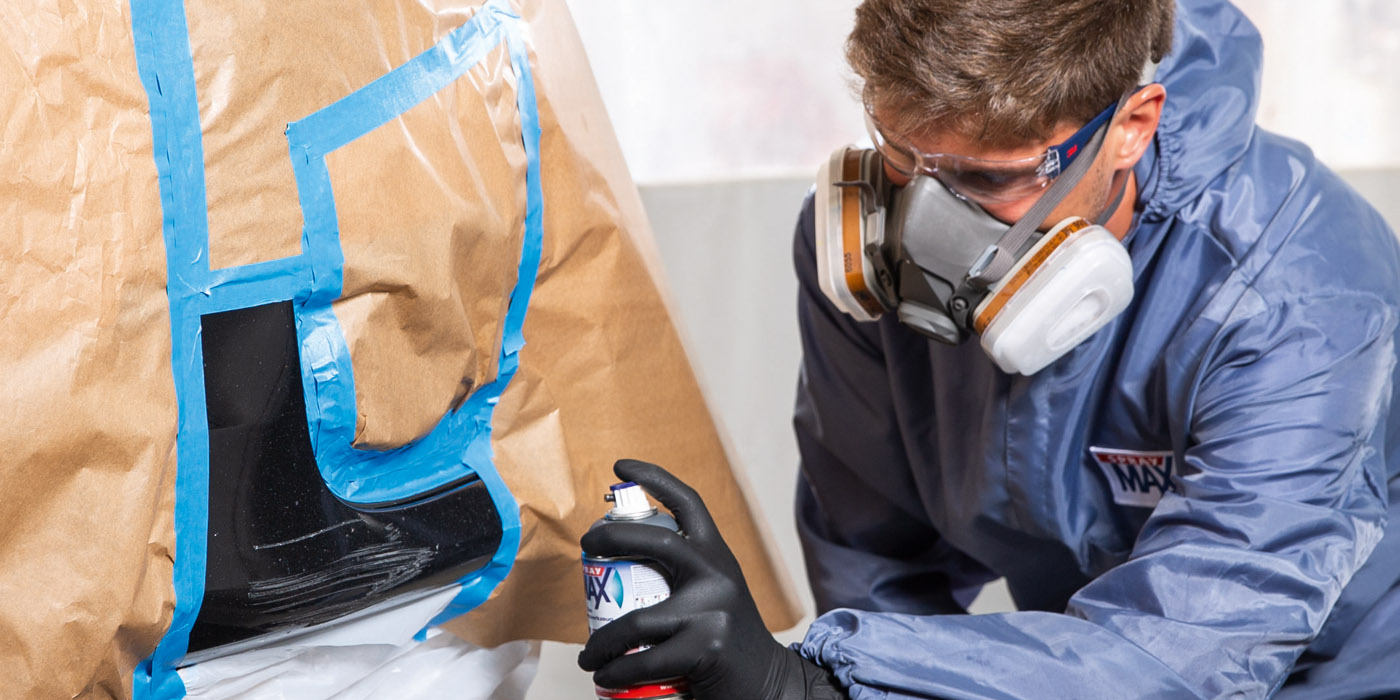Painters making errors? My editor must be kidding! Doesn’t she know that painters don’t make mistakes? Why just ask any one of ’em. You’ve got a better chance of being hit by lightning than catching a painter in a less-than-perfect moment. I think the last verifiable error was in 1959, during a game between the Everystate Allstars and the Texas State Reformatory for Refinishers game. It was the bottom of the sixth, runners on first and third, two outs …
The fact is, every day in this business, we’re faced with challenging moments that require all of our expertise and the occasional *#@! to deal with them. From there, we take a deep breath, work a little magic and get on with our lives.
But are there some common threads of paint woe that are weaved throughout the industry? From being in the paint business and talking to people all over the industry, I’d have to say yes – we can pick out a few things that consistently cause paint failures.

I’m Late, I’m Late … for a Very Important Date
Eenie meenie miney moe.
Paint it faster.
The car needs to go!!
It’s a shame that nobody in the office noticed your painter hanging out for the first three days of the week, waiting for the metal department to send cars his way. But hey, it’s not their fault they all got done on Wednesday night, and they all have to go Friday. It’s summer, and the customers want their cars for vacations.
What are you gonna do about it?
Most painters, when faced with this dilemma, assess the situation and decide what part of the refinish process to downplay on certain cars. And there are sure to be some choices made here that will negatively affect the lasting quality of work that your shop is (or used to be) known for.
“Which trim pieces can we leave on?”
“That quarter should go back to the bodyman, but we’ll just prime and putty it.”
“Hey, as long as it looks good Friday, what do I care?”
“They should know I can’t do a whole week’s worth of work in two days.”
The above scenarios aren’t all that uncommon.
It’s a shame that a few hasty choices can undermine a reputation that’s taken years to establish, but the fact is, the difference between right and wrong can boil down to a few minutes of attention to detail. In this example, the refinish technician is being put in an almost no-win situation. He’s damned if he does get them all done badly and damned if he doesn’t get them done to deliver on time.
What needs to happen for him to not be so damned?
Well … several anti-depressant medications are available. Valium is quite nice. Thorazine is a little bit much … but I bet this isn’t the answer you’re looking for.
Seriously, the answer’s twofold. First, the front office needs to understand the value of proper scheduling. They know what repairs are required for booked jobs, and they should understand the benefit to the whole operation if they strike some sort of balance between large, medium and small jobs. In the Midwest and Northern rust belts, there’s also a heightened demand for paint-only repairs in the summer months. One hundred refinish hours can be two complete paint jobs or 30 fender replacements. The number of vehicles that move through the shop in any given week can be that extreme. Know how many hours your staff is capable of generating. Review the incoming repair load for refinish hours and plan the shop schedule to allow enough in-shop time for a big paint job so you can keep the regular jobs moving through your shop in a timely fashion.
Secondly, you must define the quality standard to all the employees. Painters need to know that compromising to blast stuff through the shop isn’t an option. If quality is a concern, then you need to plug in a monitoring system. Maybe before priming, you visually inspect the car for thorough sanding and priming. If color match is a problem, spray a test panel while the car is still in the body shop so the color is matched. Or plan blending before the car is in the booth.
And furthermore …
I’ve never understood why some shop owners/managers think that every car must come in on Monday and leave on Friday. The burden this thinking places on the facility and the staff is completely unnecessary. Staggering drop-offs and deliveries makes a lot of sense.
But what about the painter who works in a well-managed shop. What situations cause him to get off track?
Incorrect color verification. In the supply side of the business, we’ve never seen so many corrections, additions, cancellations and revisions in color information. These changes come from the vehicle manufacturers and all of the major paint suppliers.
If you consistently paint cars from the same manufacturers, then you might get familiar with the latest scoop. But sometimes the first, most apparent choice won’t be the right one. You need to keep your color information current and in order, and when you’re confronted with a change, make a note of it in the color book. It also helps to have a good relationship with your paint store people and your paint rep.
Also, be sure to let your front office know if you’re facing a color-documentation problem on a vehicle. They’ll need to adjust the estimate to reflect the additional labor involved.
The Left Hand Doesn’t Know What the Right Hand’s Doing
All of these beautiful computer programs out there and still, the right hand often doesn’t let the left hand in on the secret of what actually needs painted. There’s an utter failure to verify the work required.
The bodyman wheels the car back to the paint shop, and the painters prepare the new fender and the door with filler on it. Awesome! You got it primed right away and painted it before you went home. That car flew through the refinish department.
“Oh, what’s that? The customer wants the lower third tweaked up on both sides? Ray made a note on the estimate but didn’t tell anybody else? It’s supposed to go when?”
What we have here is an unhappy customer, a perturbed painter, a ticked-off boss – and a vehicle going back through the refinish department slowing up all the other GOTTA GO jobs.
The customer, the front office, the bodyman and the painter each need to know certain key pieces of information. See to it that the paint department has clear, verified information on exactly what’s being painted on each vehicle.

Wash Me!
It used to be so easy. The cleaning solvent we used on lacquer vehicles actually melted the lacquer. I miss those reversible finishes. Now we apply bulletproof paint to invincible vehicles.
Cleanliness has never been more necessary to assure refinishing success. Though the details vary depending on your paint manufacturer, they almost invariably recommend a multi-step cleaning sequence, which often includes:
1. Washing with hot soapy water.
2. Rinse with clean water and dry.
3. Wash with a wax and grease remover (you might have to choose from five or six of these).
4. After priming and sanding, repeat the above sequence, pressure wash all panels and inner panels, and re-mask before final wash solvent, tacking and spraying.
If you talk to paint company chemists, they’ll tell you that you’ll want to think long and hard before you devise your own cleaning regimen. There are reasons for their recommendations.
Case in point: Sometimes painters decide that if it doesn’t feel slippery, they’ll just sand it and prime it. The idea of getting repairs in primer fast is appealing because then the job is working for them. But sometimes in their haste to get the job working for them, painters make critical compromises. Primer won’t adhere to contaminated surfaces any better than a topcoat will. So if the choice is made to just feather the body work and prime the job without cleaning with water and solvent, the likelihood of failure is significant.
Take It Off
If you or your shop play Russian roulette by not removing trim, gaskets, handles and locks, I suppose that’s your choice. We’ve all seen your work as we sit at a traffic light and look at the vehicle next to us. What do you call that effect? A cosmetic peel? Maybe you’ve found a way to charge extra?
Some of you folks really do this industry proud with the way you take care of customers. The best of you do work that’s visible at 70 miles an hour – as it buzzes by on the freeway.
Every vehicle manufacturer and every legitimate paint supplier are on the record in writing that trim pieces on painted panels should be removed prior to refinishing.
Love It Like Your Own
It wouldn’t be unusual today, in 2002, for an automotive refinish technician to be in charge of and responsible for $250,000 to $500,000 in assets. Land, buildings, booths, compressors, guns, prep decks – this stuff adds up fast. If you could take a deep breath and for a minute imagine yourself as a refinishing baron (your boss will love it) in charge of a refinishing empire, one of your thoughts might be: How do I best manage these assets that I’ve been given?
The best painters, the best refinishing teachers and the best employees recognize the need to maximize the use of assets and to carefully maintain them so they continue to produce positive, measurable, profitable results. In the case of refinishers, the desire is to produce consistently high-quality refinish work in a repeatable process. This means that there’s a prepared agenda for managing major devices, i.e., the booth filters are changed every 60 hours, the compressor oil is changed every 30 days, etc.
Whatever combination of equipment you have in your shop, take some time to work out who’s going to maintain things. Devise a back-up plan if a major piece of equipment fails. It’s a whole lot easier to sit and think about this stuff before disaster strikes.
Error-Free Production Doesn’t Just Happen
Awareness and communication are the tools needed to move your business toward an error-free production system. While we can point out individual situations with clearcut responsibility, we can also look at the shared nature of many failures in the collision repair and refinishing processes. This is why the quality standards in your shop must be clearly conveyed and the consequences for failure to meet them must be known.
If you wonder how some shops maintain consistently high standards without failure, ask them. If you want the single most important key to achieving perfection, it’s education.
With the ever-rising consumer demands for professionalism, educating management and technicians has never been more necessary. And the quality of courses available to this industry has never been higher.
Major vendors to the collision repair industry, in particular, the paint companies, have beefed up the quality of their course offerings. A big part of the reason for this is to comply with the Industry Training Alliance program that allows qualified classes to earn I-CAR Gold Class points for attendees. Before this program, I’d sometimes hear painters say that they felt Brand A’s trainer was more on the ball than Brand B’s. People in our business know when they’re being patronized. And they know when they’ve received valuable information that allows them to become more skilled and efficient at their craft.
The training bar has been raised, and there’s plenty of valuable courses out there.
Do yourself a favor. Get smart.
Writer Michael Regan is president of The J.J.R. Company in Cleveland, Ohio, and a contributing editor to BodyShop Business.













